Abstract
Prior studies reported an association between ambient air concentrations of total suspended particles and SO2 during pregnancy and adverse pregnancy outcomes. We examined the possible impact of particulate matter up to 10 microm (PM10) and up to 2.5 microm (PM2. 5) in size on intrauterine growth retardation (IUGR) risk in a highly polluted area of Northern Bohemia (Teplice District). The study group includes all singleton full-term births of European origin over a 2-year period in the Teplice District. Information on reproductive history, health, and lifestyle was obtained from maternal questionnaires. The mean concentrations of pollutants for each month of gestation were calculated using continuous monitoring data. Three intervals (low, medium, and high) were constructed for each pollutant (tertiles). Odds ratios (ORs) for IUGR for PM10 and PM2.5 levels were generated using logistic regression for each month of gestation after adjustment for potential confounding factors. Adjusted ORs for IUGR related to ambient PM10 levels in the first gestational month increased along the concentration intervals: medium 1.62 [95% confidence interval (CI), 1.07-2.46], high 2.64 (CI, 1.48-4.71). ORs for PM2.5 were 1.26 (CI, 0.81-1.95) and 2.11 (CI, 1. 20-3.70), respectively. No other associations of IUGR risk with particulate matter were found. Influence of particles or other associated air pollutants on fetal growth in early gestation is one of several possible explanations of these results. Timing of this effect is compatible with a current hypothesis of IUGR pathogenesis. Seasonal factors, one of the other possible explanations, is less probable. More investigation is required to examine these findings and alternative explanations.
Full text
PDF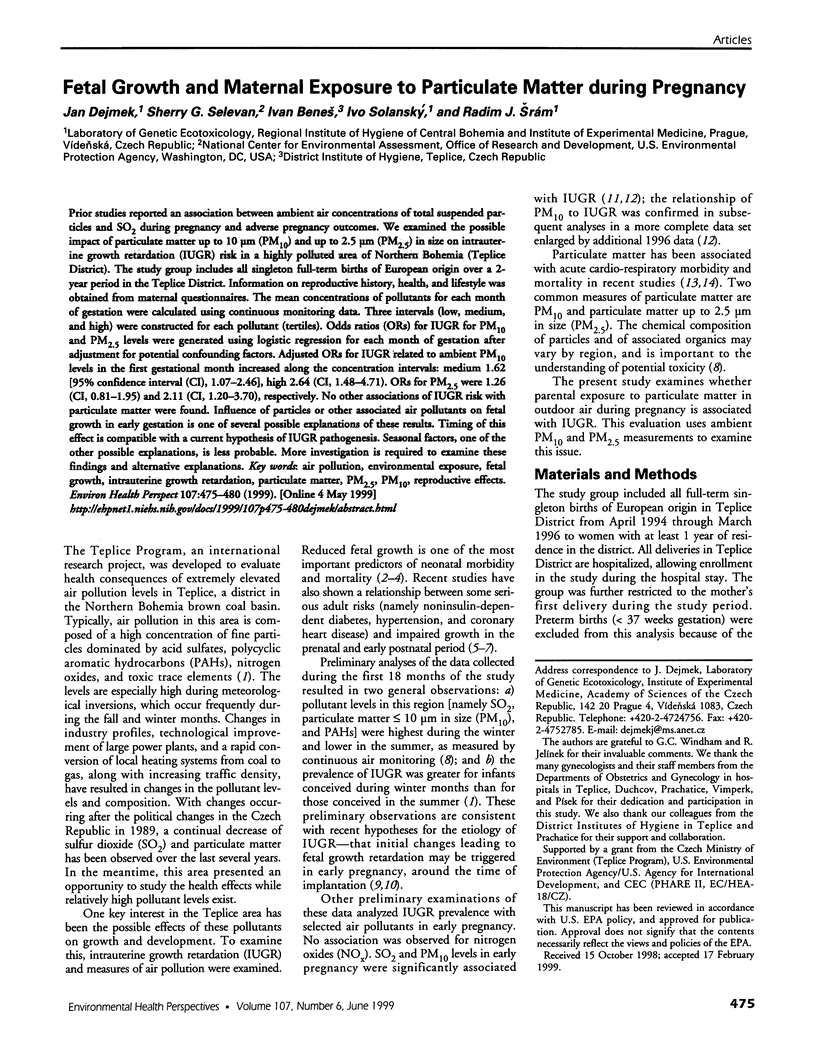
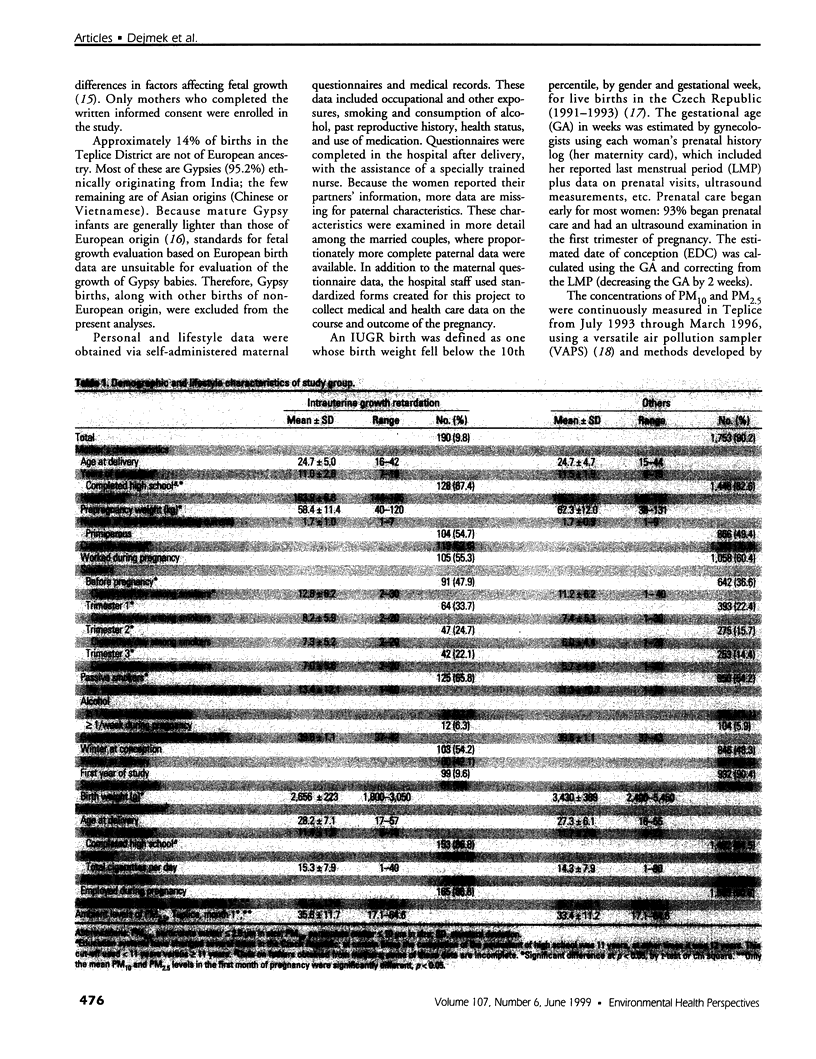
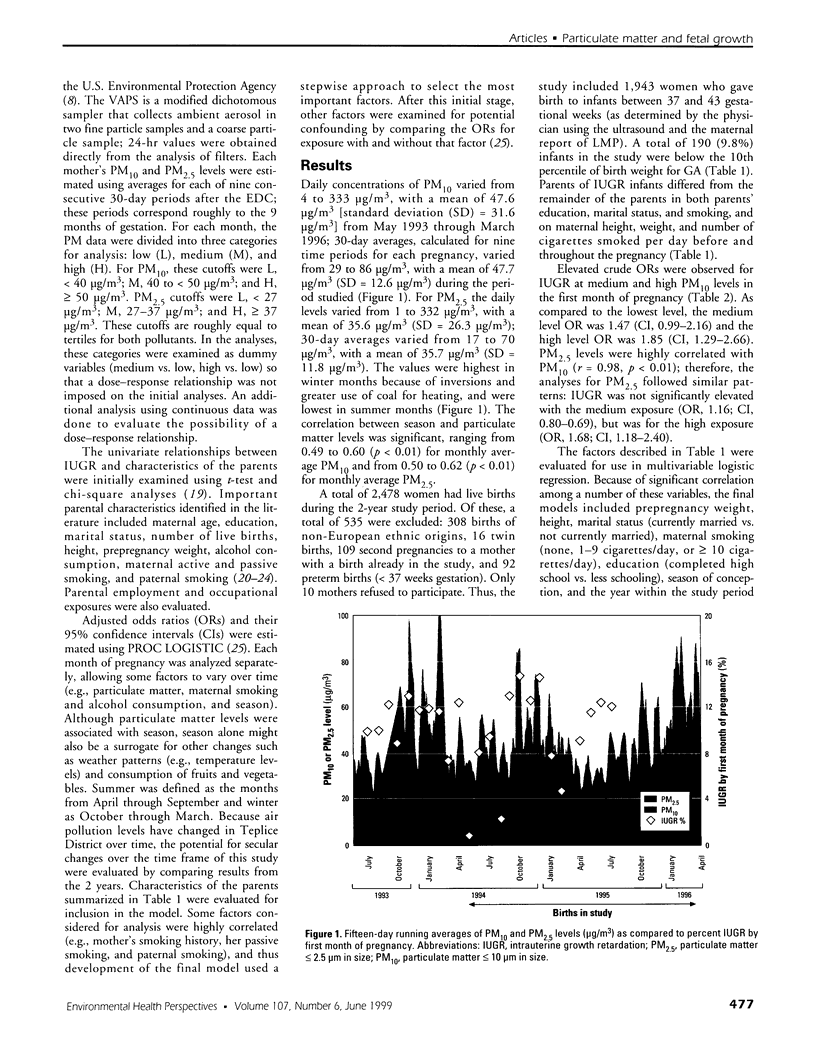
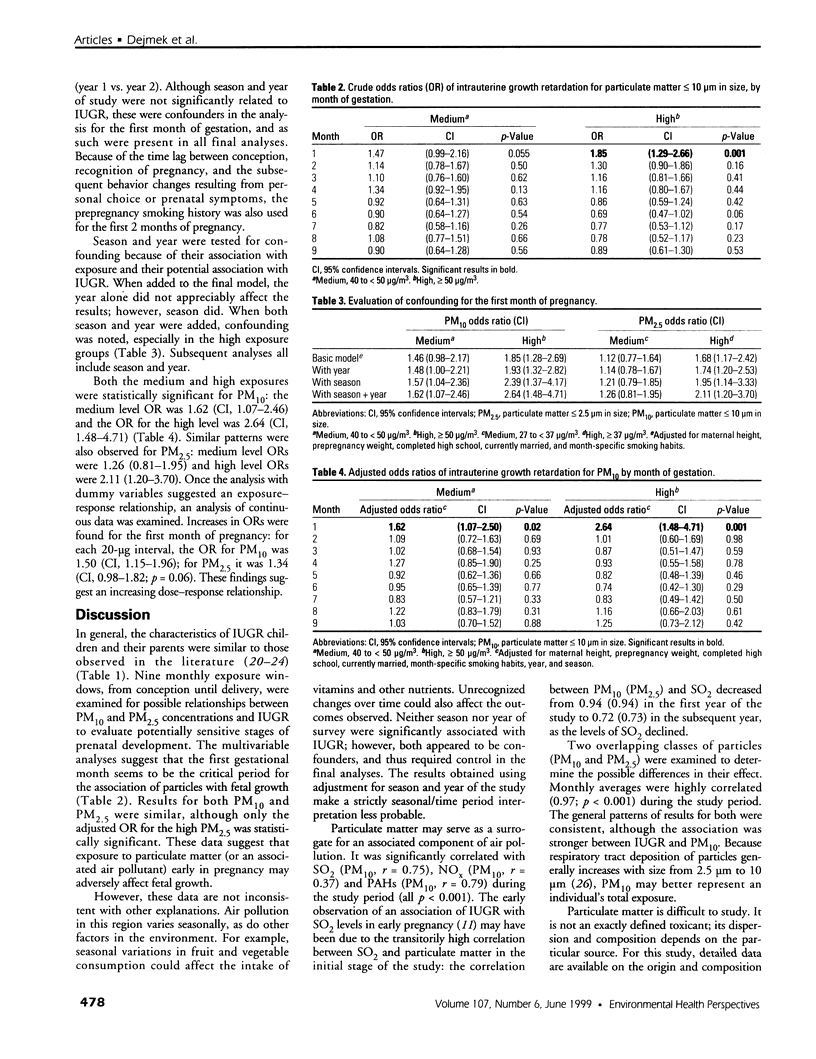
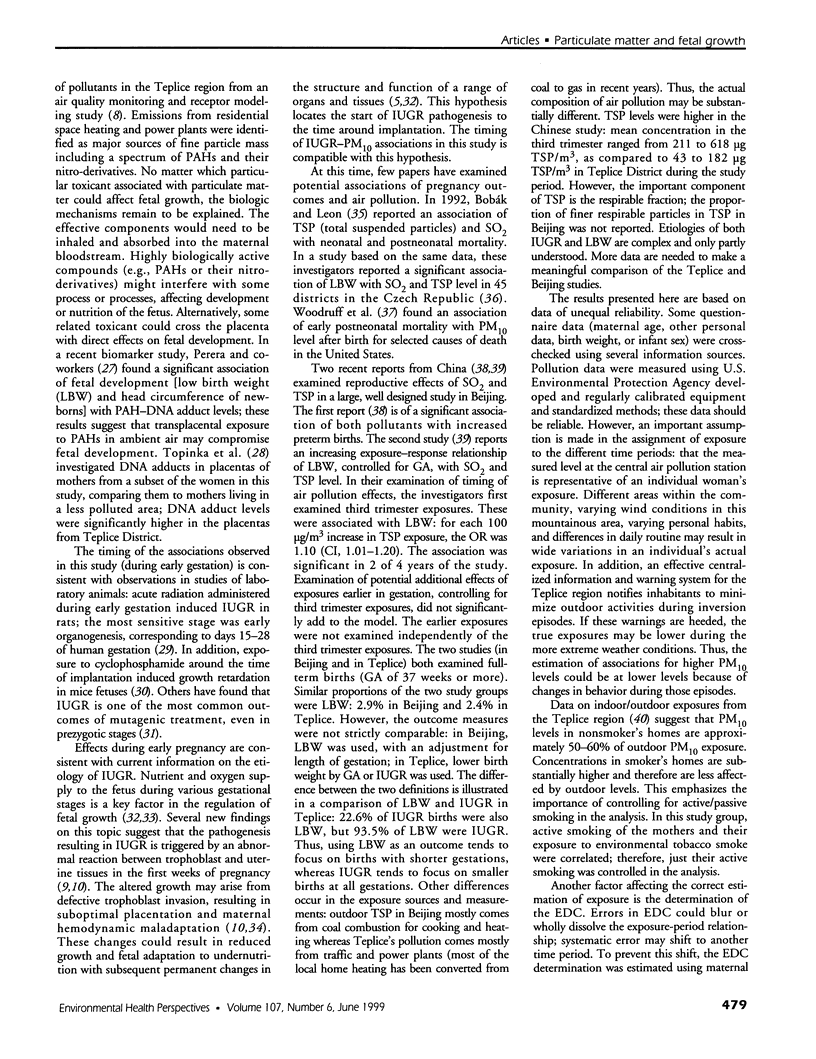
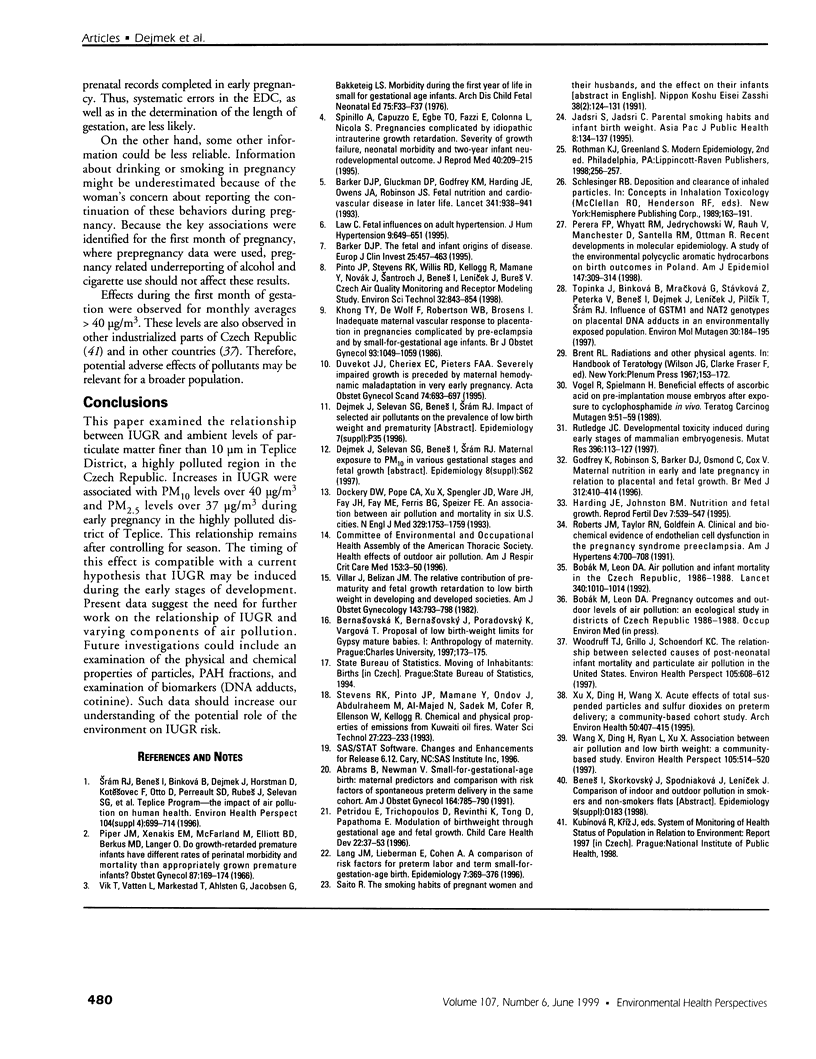
Images in this article
Selected References
These references are in PubMed. This may not be the complete list of references from this article.
- Abrams B., Newman V. Small-for-gestational-age birth: maternal predictors and comparison with risk factors of spontaneous preterm delivery in the same cohort. Am J Obstet Gynecol. 1991 Mar;164(3):785–790. doi: 10.1016/0002-9378(91)90516-t. [DOI] [PubMed] [Google Scholar]
- Barker D. J., Gluckman P. D., Godfrey K. M., Harding J. E., Owens J. A., Robinson J. S. Fetal nutrition and cardiovascular disease in adult life. Lancet. 1993 Apr 10;341(8850):938–941. doi: 10.1016/0140-6736(93)91224-a. [DOI] [PubMed] [Google Scholar]
- Barker D. J. The fetal and infant origins of disease. Eur J Clin Invest. 1995 Jul;25(7):457–463. doi: 10.1111/j.1365-2362.1995.tb01730.x. [DOI] [PubMed] [Google Scholar]
- Bobak M., Leon D. A. Air pollution and infant mortality in the Czech Republic, 1986-88. Lancet. 1992 Oct 24;340(8826):1010–1014. doi: 10.1016/0140-6736(92)93017-h. [DOI] [PubMed] [Google Scholar]
- Dockery D. W., Pope C. A., 3rd, Xu X., Spengler J. D., Ware J. H., Fay M. E., Ferris B. G., Jr, Speizer F. E. An association between air pollution and mortality in six U.S. cities. N Engl J Med. 1993 Dec 9;329(24):1753–1759. doi: 10.1056/NEJM199312093292401. [DOI] [PubMed] [Google Scholar]
- Duvekot J. J., Cheriex E. C., Pieters F. A., Peeters L. L. Severely impaired fetal growth is preceded by maternal hemodynamic maladaptation in very early pregnancy. Acta Obstet Gynecol Scand. 1995 Oct;74(9):693–697. doi: 10.3109/00016349509021176. [DOI] [PubMed] [Google Scholar]
- Godfrey K., Robinson S., Barker D. J., Osmond C., Cox V. Maternal nutrition in early and late pregnancy in relation to placental and fetal growth. BMJ. 1996 Feb 17;312(7028):410–414. doi: 10.1136/bmj.312.7028.410. [DOI] [PMC free article] [PubMed] [Google Scholar]
- Harding J. E., Johnston B. M. Nutrition and fetal growth. Reprod Fertil Dev. 1995;7(3):539–547. doi: 10.1071/rd9950539. [DOI] [PubMed] [Google Scholar]
- Jadsri S., Jadsri C. Parental smoking habits and infant birth weight. Asia Pac J Public Health. 1995;8(2):134–137. doi: 10.1177/101053959500800214. [DOI] [PubMed] [Google Scholar]
- Khong T. Y., De Wolf F., Robertson W. B., Brosens I. Inadequate maternal vascular response to placentation in pregnancies complicated by pre-eclampsia and by small-for-gestational age infants. Br J Obstet Gynaecol. 1986 Oct;93(10):1049–1059. doi: 10.1111/j.1471-0528.1986.tb07830.x. [DOI] [PubMed] [Google Scholar]
- Lang J. M., Lieberman E., Cohen A. A comparison of risk factors for preterm labor and term small-for-gestational-age birth. Epidemiology. 1996 Jul;7(4):369–376. doi: 10.1097/00001648-199607000-00006. [DOI] [PubMed] [Google Scholar]
- Law C. Fetal influences on adult hypertension. J Hum Hypertens. 1995 Aug;9(8):649–651. [PubMed] [Google Scholar]
- Perera F. P., Whyatt R. M., Jedrychowski W., Rauh V., Manchester D., Santella R. M., Ottman R. Recent developments in molecular epidemiology: A study of the effects of environmental polycyclic aromatic hydrocarbons on birth outcomes in Poland. Am J Epidemiol. 1998 Feb 1;147(3):309–314. doi: 10.1093/oxfordjournals.aje.a009451. [DOI] [PubMed] [Google Scholar]
- Petridou E., Trichopoulos D., Revinthi K., Tong D., Papathoma E. Modulation of birthweight through gestational age and fetal growth. Child Care Health Dev. 1996 Jan;22(1):37–53. [PubMed] [Google Scholar]
- Piper J. M., Xenakis E. M., McFarland M., Elliott B. D., Berkus M. D., Langer O. Do growth-retarded premature infants have different rates of perinatal morbidity and mortality than appropriately grown premature infants? Obstet Gynecol. 1996 Feb;87(2):169–174. doi: 10.1016/0029-7844(95)00400-9. [DOI] [PubMed] [Google Scholar]
- Roberts J. M., Taylor R. N., Goldfien A. Clinical and biochemical evidence of endothelial cell dysfunction in the pregnancy syndrome preeclampsia. Am J Hypertens. 1991 Aug;4(8):700–708. doi: 10.1093/ajh/4.8.700. [DOI] [PubMed] [Google Scholar]
- Rutledge J. C. Developmental toxicity induced during early stages of mammalian embryogenesis. Mutat Res. 1997 Dec 12;396(1-2):113–127. doi: 10.1016/s0027-5107(97)00178-4. [DOI] [PubMed] [Google Scholar]
- Saito R. [The smoking habits of pregnant women and their husbands, and the effect on their infants]. Nihon Koshu Eisei Zasshi. 1991 Feb;38(2):124–131. [PubMed] [Google Scholar]
- Spinillo A., Capuzzo E., Egbe T. O., Fazzi E., Colonna L., Nicola S. Pregnancies complicated by idiopathic intrauterine growth retardation. Severity of growth failure, neonatal morbidity and two-year infant neurodevelopmental outcome. J Reprod Med. 1995 Mar;40(3):209–215. [PubMed] [Google Scholar]
- Srám R. J., Benes I., Binková B., Dejmek J., Horstman D., Kotesovec F., Otto D., Perreault S. D., Rubes J., Selevan S. G. Teplice program--the impact of air pollution on human health. Environ Health Perspect. 1996 Aug;104 (Suppl 4):699–714. doi: 10.1289/ehp.104-1469669. [DOI] [PMC free article] [PubMed] [Google Scholar]
- Topinka J., Binková B., Mracková G., Stávková Z., Peterka V., Benes I., Dejmek J., Lenícek J., Pilcík T., Srám R. J. Influence of GSTM1 and NAT2 genotypes on placental DNA adducts in an environmentally exposed population. Environ Mol Mutagen. 1997;30(2):184–195. [PubMed] [Google Scholar]
- Vik T., Vatten L., Markestad T., Ahlsten G., Jacobsen G., Bakketeig L. S. Morbidity during the first year of life in small for gestational age infants. Arch Dis Child Fetal Neonatal Ed. 1996 Jul;75(1):F33–F37. doi: 10.1136/fn.75.1.f33. [DOI] [PMC free article] [PubMed] [Google Scholar]
- Villar J., Belizán J. M. The relative contribution of prematurity and fetal growth retardation to low birth weight in developing and developed societies. Am J Obstet Gynecol. 1982 Aug 1;143(7):793–798. doi: 10.1016/0002-9378(82)90012-6. [DOI] [PubMed] [Google Scholar]
- Vogel R., Spielmann H. Beneficial effects of ascorbic acid on preimplantation mouse embryos after exposure to cyclophosphamide in vivo. Teratog Carcinog Mutagen. 1989;9(1):51–59. doi: 10.1002/tcm.1770090107. [DOI] [PubMed] [Google Scholar]
- Wang X., Ding H., Ryan L., Xu X. Association between air pollution and low birth weight: a community-based study. Environ Health Perspect. 1997 May;105(5):514–520. doi: 10.1289/ehp.97105514. [DOI] [PMC free article] [PubMed] [Google Scholar]
- Woodruff T. J., Grillo J., Schoendorf K. C. The relationship between selected causes of postneonatal infant mortality and particulate air pollution in the United States. Environ Health Perspect. 1997 Jun;105(6):608–612. doi: 10.1289/ehp.97105608. [DOI] [PMC free article] [PubMed] [Google Scholar]
- Xu X., Ding H., Wang X. Acute effects of total suspended particles and sulfur dioxides on preterm delivery: a community-based cohort study. Arch Environ Health. 1995 Nov-Dec;50(6):407–415. doi: 10.1080/00039896.1995.9935976. [DOI] [PubMed] [Google Scholar]



